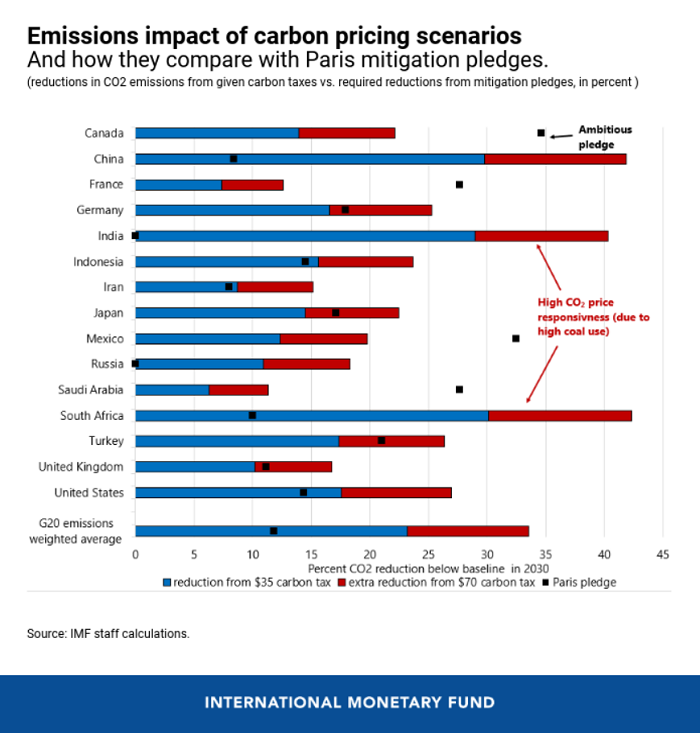Showing posts with label Energy & Climate Change. Show all posts
Tuesday, June 11, 2019
IMF’s Ian Parry receives the IAEE’s 2019 annual prize for outstanding contributions to the field
The International Association for Energy Economics (IAEE) has awarded Ian Parry (IMF) the 2019 annual prize for outstanding contributions to the field of energy economics and its literature.
Ian Parry is Principal Environmental Fiscal Policy Expert in the IMF’s Fiscal Affairs Department, specializing in fiscal analysis of climate change, environment, and energy issues. Before joining the Fund in 2010, Ian held the Allen V. Kneese Chair in Environmental Economics at Resources for the Future. Below are some of latest posts by Ian Parry.
The International Association for Energy Economics (IAEE) has awarded Ian Parry (IMF) the 2019 annual prize for outstanding contributions to the field of energy economics and its literature.
Ian Parry is Principal Environmental Fiscal Policy Expert in the IMF’s Fiscal Affairs Department, specializing in fiscal analysis of climate change, environment, and energy issues. Before joining the Fund in 2010, Ian held the Allen V. Kneese Chair in Environmental Economics at Resources for the Future.
Posted by at 5:05 PM
Labels: Energy & Climate Change
Wednesday, June 5, 2019
Animated chart of US oil production by state, 1981-2018
From American Enterprise Institute:
“A big thanks to my former AEI colleague Olivier Ballou for helping me find the UK-based website Flourish, which allowed me create the “bar chart race” visualization above showing annual oil production (barrels per day) in the top ten oil-producing states (including federal offshore production) from 1981 to 2018. Perhaps the most interesting trend is to watch the rise of oil production in North Dakota. The state ranked No. 10 until about 2005, when revolutionary drilling and extraction technologies tapped into previously inaccessible shale oil deposits in the Bakken Formation in western North Dakota, and the state then rose to the No. 2 oil-producing US state by 2015 behind only Texas (and offshore production). Also notice the significant declines in conventional oil production in Alaska (from more than 2 million barrels per day in 1988 to below 500,000 bpd by 2014) and California (from more than 1 million bpd in the early 1980s to below 500,000 bpd in 2017).
The Flourish website is pretty user-friendly and I’ll try to produce more “bar chart race” visualizations in the future. If you have any ideas, please leave them in the comment section.”
From American Enterprise Institute:
“A big thanks to my former AEI colleague Olivier Ballou for helping me find the UK-based website Flourish, which allowed me create the “bar chart race” visualization above showing annual oil production (barrels per day) in the top ten oil-producing states (including federal offshore production) from 1981 to 2018. Perhaps the most interesting trend is to watch the rise of oil production in North Dakota.
Posted by at 9:03 AM
Labels: Energy & Climate Change
Thursday, May 30, 2019
A case for second-best solutions in climate policy
From the Financial Times:
The Greens’ surge in last week’s European Parliament elections confirmed that a growing share of voters want their politicians to do something about climate change. But it is far from clear that the majority is ready to pay the higher energy and fuel prices that would result from any serious effort to limit the rise in global temperatures — and that would hit some groups much harder than others.
Economists, who for years have been debating the best ways to fine-tune carbon pricing mechanisms, are now turning their attention to the bigger challenges of political economy.
A paper by IMF staff, published earlier this month, shows just how far off we are from making carbon as expensive as it needs to be. Many major economies could achieve the emissions cuts pledged under the 2015 Paris accord with a carbon price of $35 per tonne, they calculate — a level that would roughly double coal prices and add 5 per cent to 7 per cent to pump prices for road fuels.
But to contain global warming to 2 degrees centigrade above pre-industrial levels would require a global carbon price of about $70 per tonne, they estimate. At present, despite a proliferation of national and sub-national carbon taxes and trading schemes, the average global carbon price is $2 per tonne.”
Continue reading here.
From the Financial Times:
The Greens’ surge in last week’s European Parliament elections confirmed that a growing share of voters want their politicians to do something about climate change. But it is far from clear that the majority is ready to pay the higher energy and fuel prices that would result from any serious effort to limit the rise in global temperatures — and that would hit some groups much harder than others.
Posted by at 8:47 AM
Labels: Energy & Climate Change
Thursday, May 23, 2019
Shorter working weeks needed to tackle climate crisis
From EconoSpeak:
“The U.K. think tank Autonomy has issued a report calling for much shorter working weeks, “The Ecological Limits of Work: on carbon emissions, carbon budgets and working time,” which is featured in a Guardian article published today, “Much shorter working weeks needed to tackle climate crisis – study.”
People across Europe will need to work drastically fewer hours to avoid disastrous climate heating unless there is a radical decarbonising of the economy, according to a study.
The research, from thinktank Autonomy, shows workers in the UK would need to move to nine-hour weeks to keep the country on track to avoid more than 2C of heating at current carbon intensity levels. Similar reductions were found to be necessary in Sweden and Germany.
The findings are based on OECD and UN data on greenhouse gas emissions per industry in the three countries. It found that at current carbon levels, all three would require a drastic reduction in working hours as well as urgent measures to decarbonise the economy to prevent climate breakdown.
Will Stronge, the director of Autonomy, said the research highlighted the need to include reductions in working hours as part of the efforts to address the climate emergency.”
From EconoSpeak:
“The U.K. think tank Autonomy has issued a report calling for much shorter working weeks, “The Ecological Limits of Work: on carbon emissions, carbon budgets and working time,” which is featured in a Guardian article published today, “Much shorter working weeks needed to tackle climate crisis – study.”
People across Europe will need to work drastically fewer hours to avoid disastrous climate heating unless there is a radical decarbonising of the economy,
Posted by at 9:57 AM
Labels: Energy & Climate Change
Tuesday, May 21, 2019
Climate Change Heterogeneity
From Francis Diebold:
“One can only go so far in climate econometrics studying time series like the proverbial “global average temperature”, just as one can only go so far in macroeconomics with the proverbial “representative agent”. Disaggregation will be key to additional progress, as different people in different places experience different climate “treatments” and different economic outcomes. The impressive new paper below begins to confront the massive tasks of data collection, manipulation, analysis, and visualization, in the context of a disaggregated analysis of the effects of temperature change on aggregate output.
“Climatic Constraints on Aggregate Economic Output”, by Marshall Burke and Vincent Tanutama, NBER Working Paper No. 25779, 2019.
Abstract: Efficient responses to climate change require accurate estimates of both aggregate damages and where and to whom they occur. While specific case studies and simulations have suggested that climate change disproportionately affects the poor, large-scale direct evidence of the magnitude and origins of this disparity is lacking. Similarly, evidence on aggregate damages, which is a central input into the evaluation of mitigation policy, often relies on country-level data whose accuracy has been questioned. Here we assemble longitudinal data on economic output from over 11,000 districts across 37 countries, including previously nondigitized sources in multiple languages, to assess both the aggregate and distributional impacts of warming temperatures. We find that local-level growth in aggregate output responds non-linearly to temperature across all regions, with output peaking at cooler temperatures (<10°C) than estimated in earlier country analyses and declining steeply thereafter. Long difference estimates of the impact of longer-term (decadal) trends in temperature on income are larger than estimates from an annual panel model, providing additional evidence for growth effects. Impacts of a given temperature exposure do not vary meaningfully between rich and poor regions, but exposure to damaging temperatures is much more common in poor regions. These results indicate that additional warming will exacerbate inequality, particularly across countries, and that economic development alone will be unlikely to reduce damages, as commonly hypothesized. We estimate that since 2000, warming has already cost both the US and the EU at least $4 trillion in lost output, and tropical countries are >5% poorer than they would have been without this warming.”
From Francis Diebold:
“One can only go so far in climate econometrics studying time series like the proverbial “global average temperature”, just as one can only go so far in macroeconomics with the proverbial “representative agent”. Disaggregation will be key to additional progress, as different people in different places experience different climate “treatments” and different economic outcomes. The impressive new paper below begins to confront the massive tasks of data collection,
Posted by at 8:15 AM
Labels: Energy & Climate Change
Subscribe to: Posts

